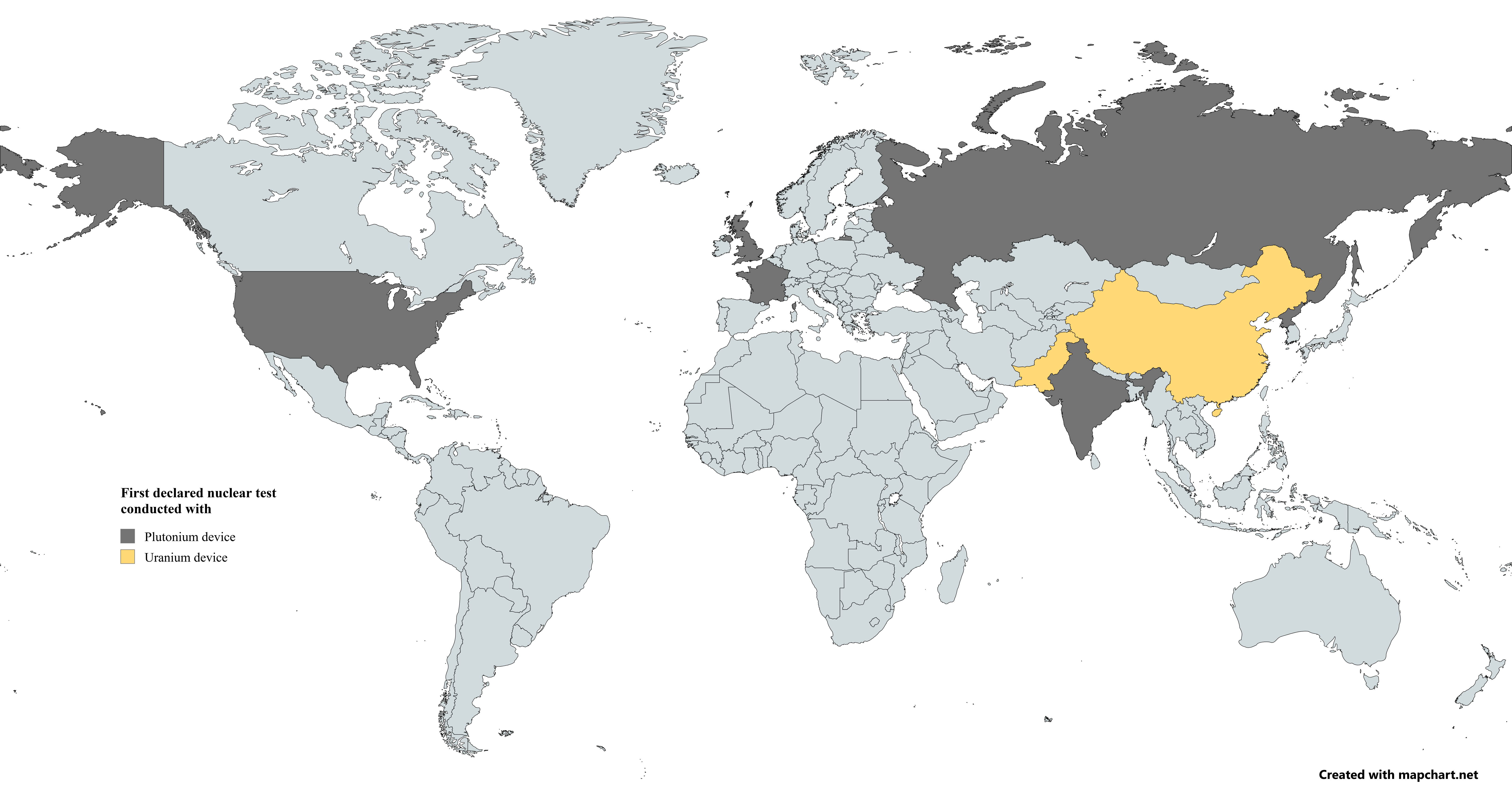Fissile Material Used in First Nuclear Weapons Test Map


David Chen
Data Visualization Specialist
David Chen is an expert in transforming complex geographic datasets into compelling visual narratives. He combines his background in computer science ...
Geographic Analysis
What This Map Shows
This map provides a detailed view of the fissile materials used in the first declared nuclear weapons tests by various countries. It highlights the specific isotopes utilized in these tests, such as uranium-235 and plutonium-239, and maps out the timeline of each country's nuclear advancements. Understanding the origins and types of fissile materials gives us crucial insight into the historical context of nuclear weapons development and proliferation.
Deep Dive into Fissile Materials
Fissile materials are a select group of isotopes capable of sustaining a nuclear chain reaction. The two primary fissile materials used in nuclear weapons are uranium-235 and plutonium-239. Uranium-235 is naturally occurring, constituting about 0.7% of natural uranium. It is extracted through a process of enrichment, which increases its concentration to levels sufficient for weaponization. On the other hand, plutonium-239 is not found in nature and is produced in nuclear reactors from uranium-238.
Interestingly, the choice of fissile material can significantly influence a country's nuclear strategy. For instance, the United States primarily relied on uranium-235 for its early atomic bombs, such as those dropped on Hiroshima and Nagasaki in 1945. In contrast, the Soviet Union opted for plutonium-239 in its initial nuclear tests, reflecting a different approach to weapon design and production.
The first declared nuclear test occurred on July 16, 1945, in New Mexico, known as the Trinity Test. This test utilized plutonium-239 and marked a significant moment in history, showcasing the destructive potential of nuclear technology. Following the United States, the Soviet Union conducted its first test in 1949, employing a bomb based on uranium-235. This strategic choice highlighted a race between superpowers to develop and deploy nuclear arsenals.
As countries progressed through the cold war, they continued to develop both fissile materials and delivery systems, which allowed for more advanced nuclear weapon designs. The proliferation of these materials has led nations to consider not just the quantity of fissile materials they possess, but also the quality and variety of the isotopes used in weapons development.
Regional Analysis
When examining the map and its implications, it’s essential to analyze the regional distribution of fissile material usage. Countries such as the United States and Russia have extensive histories of nuclear testing, with a significant number of tests attributed to each. The U.S. primarily used plutonium-239 in its early tests, while Russia showcased a mix of uranium-235 and plutonium-239 in its arsenal.
In contrast, countries like France and the United Kingdom also followed suit, with their first tests occurring in the 1960s. France's first test on February 13, 1960, used plutonium-239, while the UK opted for uranium-235 in its initial test. Interestingly, China entered the nuclear arena later, with its first test in 1964 also utilizing uranium-235, showing a pattern of following earlier superpower developments.
Emerging nuclear states, such as India and Pakistan, used different strategies in their fissile material choices. India conducted its first test in 1974 using plutonium-239, while Pakistan followed in 1998 with a mix of uranium-235 and plutonium-239, revealing a strategic evolution in nuclear capabilities across different geopolitical contexts.
Significance and Impact
Understanding the fissile materials used in nuclear weapons tests is vital not just for historical knowledge but also for comprehending current geopolitical tensions. The existence of these materials poses ongoing risks not only to the nations that possess them but also to global security. As countries continue to develop their nuclear capabilities, concerns over proliferation and the potential for catastrophic events rise.
In recent years, international agreements and treaties, such as the Treaty on the Non-Proliferation of Nuclear Weapons (NPT), have sought to curb the spread of fissile materials. However, the effectiveness of these treaties is often challenged by geopolitical rivalries and emerging nuclear states. As we move forward, the conversation around fissile materials and their implications will remain crucial in discussions about global peace and security.
The future of nuclear energy and weaponry also hinges on advancements in technology and international diplomacy. With increasing tensions in various regions, understanding the fissile materials used in nuclear weapons tests can provide critical insight into potential flashpoints and the importance of effective arms control measures.
Visualization Details
- Published
- August 15, 2025
- Views
- 112
Comments
Loading comments...